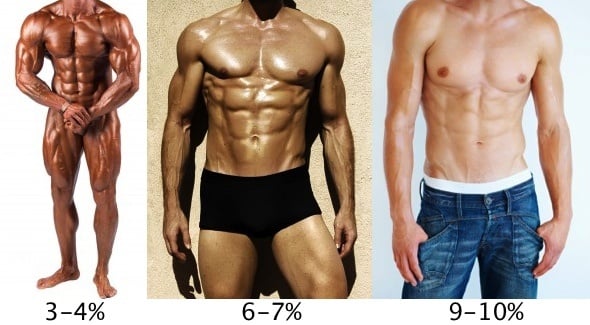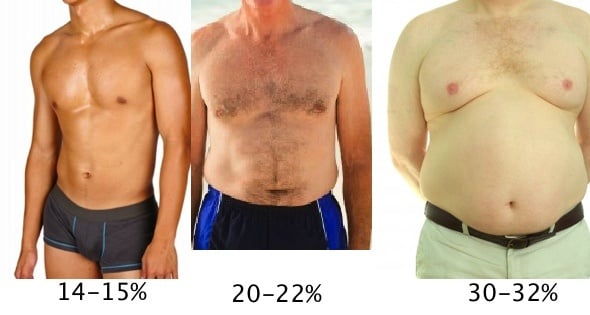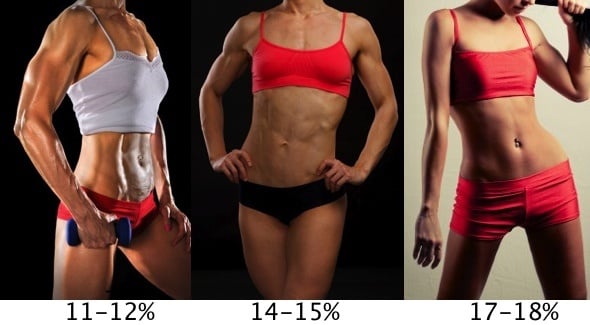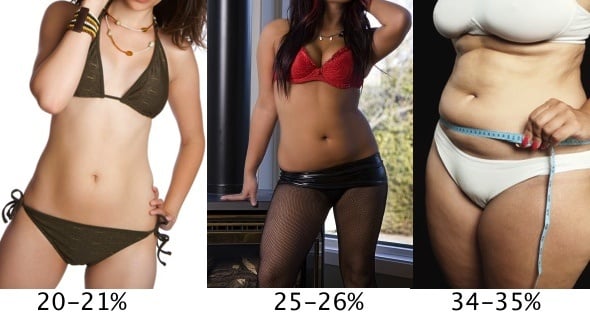Everything You Need to Know About Body Fat Percentage

What the #$%@ is body fat percentage?
What’s a good amount of body fat to aim for?
How the heck do I figure it out how muchI have?
Body fat is an incredibly tricky subject – it’s tough to calculate, tough to track, and most people are way off in their estimates of what they think their body fat percentage is.
As Kanye West once famously declared, “that right there could drive a sane man berserk.”
Luckily, you’re reading Nerd Fitness, which means you’re smart, funny, good looking AND modest. You also understand that this is one of those things that you should probably know something about.
And since we’re talking about kind of a dry, scientific subject here, you’ll be rewarded with cute animal videos at the end of each section so you don’t fall asleep on me.
Fair warning: lots of half-naked people of all different levels of body fat in this article!
What is body fat percentage?

In its simplest form: body fat is the amount of fat in your body, compared to everything else. Everything else includes your organs, muscles, bones, tendons, water, and so on.
Both men and women carry different amounts of body fat percentage due to…you know…being different.
A super ripped male body builder who is minimizing body fat percentage could have a percentage down as low as 3-4%, while a super ripped female body builder who is minimizing body fat percentage would only get as low as 8-9%. A male athlete could be in fantastic shape and have 10% body fat, while a women at comparable level of athleticism and appearance might be at 18-20% body fat. To take the comparison to the other end of the spectrum, an overweight male at 30% will look vastly different than an overweight woman at 30%.
Feel free to take a break with this video of a lion cub hanging out with a puppy and a rabbit.
What’s a good amount of body fat to have?
Here is the generally accepted chart for women and men when it comes to body fat percentage:
Women
|
Men
| |
Essential fat
|
10-12%
|
2-4%
|
Athletes
|
14-20%
|
6-13%
|
Fitness
|
21-24%
|
14-17%
|
Acceptable
|
25-31%
|
18-25%
|
Obese
|
32% plus
|
26% plus
|
In what I’m sure is news to nobody, body fat is essential to survival - fat protects your internal organs, provides you with necessary energy stores in times of peril, and more.
“Essential fat” means the minimal amount of fat required for survival -Anything less than this amount would mostly likely result in organ failure, but even approaching this amount of body fat is dangerous. It’s for this reason that bodybuilders, who can minimize their body fat to the “essential fat” level only do so when prepping for a show – during the rest of the year they maintain a higher body fat percentage so that they can stay healthy and function properly.
If you are looking to have that “ripped” look (dudes) and “toned” look (ladies), you’ll want your body fat percentage to hover in the “athletes” section.
If you’re looking to look healthy, I’d argue that you’ll want to be in the fitness range. Once you get into the upper ends of “acceptable” and “obese,” a decrease in body fat percentage would benefit your health.
So, determining what’s an optimal goal for you:
- If you are trying to look like Ryan Reynolds or Jessica Beil in Blade III, good luck! Aim for a body fat percentage of 6-8% (men) or 13-15% (women). Note: your athletic/strength gaining performance will most likely suffer at this percentage, and might not be worth it. Your call.
- If you are interested in getting that coveted six pack, drop your body fat down to the 8-11% range for dudes and 15-17% range for women.
- If you are an athlete and interested in optimal athletic performance, aim for a body fat percentage around 15% (men) or 20% (women). NF team memberStaci trains much better at 20% body fat than at 15% body fat.
- If you are just interested in looking pretty good and feeling pretty good, anything less than 18% for men and anywhere in the 20-23% range for women should get you the “hey, lookin pretty good!” response from your friends .
- For the ladies! If you are concerned about menstruation or fertility, it has been said not to drop below 15% body fat. Although I can’t find any studies that definitively refutes or proves this, I’ve read it all over the place, so just something to be aware of. Your results may vary!
Hey, you’re still awake! You’ve unlocked the “cute baby pigmy goat jumping around” video.
What do these amounts look like?
Below, you’ll see images of what people look like with different amounts of body fat.
Men:


Women:


A quick note: your body fat percentage is just the amount of body fat you have; it has nothing to do with the amount of muscle mass you have, which means you can have two people with the same amount of body fat percentage that look WAY different from each other. Scroll down around halfway on this article for two great examples.
Are you surprised about what you thought and what the actual percentages look like? For a chuckle, look at THESE people who have ‘self-estimated’ their own body fat percentage! Click through the different images and compare the percentages of the people above to the people in the link. It’s clear they didn’t actually get measured, as most of them aren’t even CLOSE.
How do you calculate your body fat percentage?

The question I get asked above ALLLLLL others.
There are seven main methods that you can use, each with varying levels of accuracy and cost:
1) Take a Look - This might be my favorite method, although it requires a trained eye and isn’t exact. By having an accurate list of pictures and comparing a picture of yourself, you can determine somewhat closely what your body fat percentage is. This is a great article I’ve found for accurate portrayal of body fat percentage. Make sure to note the difference in the two men, both at 10% body fat further down the page.
2) Body Fat Calipers – Pick up a set of calipers for $5. Pull the fat away from your muscles, pinch them with the caliper, take the measurements, and look at a chart to figure out your body fat percentage. Some recommend using one test site, some multiple. In my experience, I have found that these calipers tend to underestimate body fat percentage (mine tell me that i’m 9 or 10% when I’m really 12%, and Staci’s say she’s 17% when she’s more like 20%), but are surprisingly accurate considering how cheap they are. Check out more information on caliper use.
3) The measurement method - By taking measurements (like the US Navy measurement or the YMCA measurement), you can calculate your body fat percentage. I have found, as have others, that this method isn’t incredibly accurate as it can very easily overestimate your body fat. Considering it only takes a few points of data, this is not surprising.
4) Body fat scales and monitors - An electrical current is sent through your body and uses “biometrical impedance analysis.” I don’t really like this method, as I find the number that it spits out to be horribly inaccurate; because they send an electrical current through your body, the amount of water you are carrying can drastically adjust this number.
5) The Bod Pod - The method calculates your body fat percentage by using air displacement to measure your body mass, volume, and density. This is also pretty darn accurate, but also pretty darn expensive at usually around $75 per session. Find a bod pod location by putting in your location in the right hand column.
6) Water displacement - Although very accurate (within 1-3% percent), it’s expensive, tedious, and a huge pain in the butt. If anybody has any experience with a water displacement test, please share your story in the comments.
7) DEXA Scanning- This is considered the most accurate method, as it actually takes a full dual X-ray of your body composition and gives you numbers. You can get this done at a health facility, and involves you lying on an X-Ray table for about 10 minutes. It’s typically very expensive, anywhere from $100-$250 per session.
VERY IMPORTANT: If you are going to start testing your body fat percentage, do whatever you can to test yourself under the same conditions each and every time. For example: every Monday morning, on an empty stomach, while drinking a single glass of water. This way, even if you’re not getting the correct body fat percentage (due to user error), you’ll at least get a consistent incorrect body fat percentage and can calculate how much you lost or if you are progressing in the right way.
“Steve, just tell me the best method!”
If you have the money, and you have a Bod Pod center close to you, then I’d say this would be the best combination of practicality and accuracy. If you don’t have the money, then I would go with a simple body fat caliper, along with the “take a look” method. Take a photo of yourself each week and compare the photos to the photosin the article above.
Here’s the thing with body fat percentage: although it’s fun to know and fun to see it getting lower as you get leaner, methods to track it can often be inaccurate. Take multiple tests with your preferred methods and understand that even then it might be off by 1-3% in either direction.
It comes down to this: Look in the mirror: do you like how you look? Awesome. Do you NOT like what you see? Follow the advice in the next section.
Another section, another reward. You’ve unlocked the “baby otter attacks a stuffed animal walrus” video.
What’s the best way to lower body fat percentage?

Alrighty! Let’s say you’re interested in dropping your body fat percentage, like my boy Saint here (whose FULL story you can read).
Here’s the best methods that I’ve found to get down to very low body fat percentages. Note: these are JUST suggestions, your results may vary! If you only want to drop a few percentage points, you can start with the advice at the top, and work your way down towards the bottom as you get lower and lower - the closer you get to single digits (dudes) or low double digits (ladies), the more strict you need to be with your diet and training.
Eat a caloric deficit – Although I believe there is more to it than just this, in order to lose weight, you need to be eating a caloric deficit – burning more calories than you consume. If you are not strength training and still consuming lots of carbohydrates, you will most likely be losing muscle along with fat, which is not optimal but will help you lose body fat.
Lift heavy things - When you strength train with heavy objects (or with intense body weight training), you get stronger and keep the muscle mass that you already have. On top of that, you also push your metabolism into an “afterburner” effect which burns extra calories even after you are done working out.
Sprints – When you run sprints, you create a similar afterburner effect with strength training, meaning extra calories burned after the completion of your workout.
Eat less than 100 grams of carbohydrates per day - When you deprive your body of carbohydrates, it no longer has steady access to its preferred source of energy, sugar (which all carbs become once they’re consumed and processed by your body). It now has to pull from fat storage to fuel itself.
Follow the Paleo Diet – I am biased here, but this is the diet that I follow whenever I need to drop weight. I recently dropped from 13-14% down to 10-11% in back in March for a vacation. I had only followed this plan for three weeks (heavy strength training, Paleo Diet, and working out in a fasted state). As you get very low, I would recommend cutting on almost all fruit and nuts and focusing on just consuming protein and vegetables.
Work out in a fasted state - Although advanced techniques to get to super low body fat percentages are beyond the scope of this article, here’s another tactic if you want to drop the last few percentage points: strength training in a fasted state first thing in the morning, and don’t consume your first meal of the day until at least 30 minutes to an hour AFTER your workout. This is a technique taught to me by Vic Magary who has used it to drop incredible amounts of body fat in a short amount of time.
How is Body Fat Percent different from Body Mass Index?

When you go to a doctor, they will most likely calculate your Body Mass Index (BMI).
Body Mass Index looks at your height and your weigh; based off this ratio, it tells you whether you are underweight, normal, overweight, or obese.
Seems pretty straight forward right? Obviously, as your weight increases disproportionately compared to your height, you are more likely to be overweight. Notice I just said “more likely.”
Here’s why: Your BMI has absolutely NOTHING to do with your body composition – it only factors in your height and weight. It will give you the same reading if you’re made of 180 pounds of pure muscle, or 180 pounds of pure Cheetos.
For example, if I was six feet tall and 185 pounds witha body fat percentage of 10%, I would be put in the same “overweight” category as a guy who was six feet tall, 185 pounds, and a body fat percentage of 25%. If two women have the same amount of body fat, and one tends to carry more water weight or have bigger bones than the other, one woman could be considered “overweight” while the other might be “average.”
Need a more obvious example proving BMI’s futility?
Lebron James is considered borderline obese when measured on the BMI scale, at a height of 6’8″ and 250 pounds.
Would you like to tell him, or should I?
That being said, I do believe BMI can be helpful - if you are above 30% body fat, then both your BMI and your body fat percentage would tell you that weight loss should be your primary goal. HOWEVER, as soon as you start to get serious about your body weight and training, then BMI quickly loses its appeal.
Feel free to take note take note of your BMI, and then move onto the important stuff.
You’ve unlocked the final reward: “jack russell terrier and her adopted children, a piglet and a baby leopard” video.
What other questions do you have?

And that concludes today’s lesson on body fat percentage, friend!
I’d love to help answer any OTHER questions you have! Just leave a comment and I’ll do my best to help out!

No comments:
Post a Comment